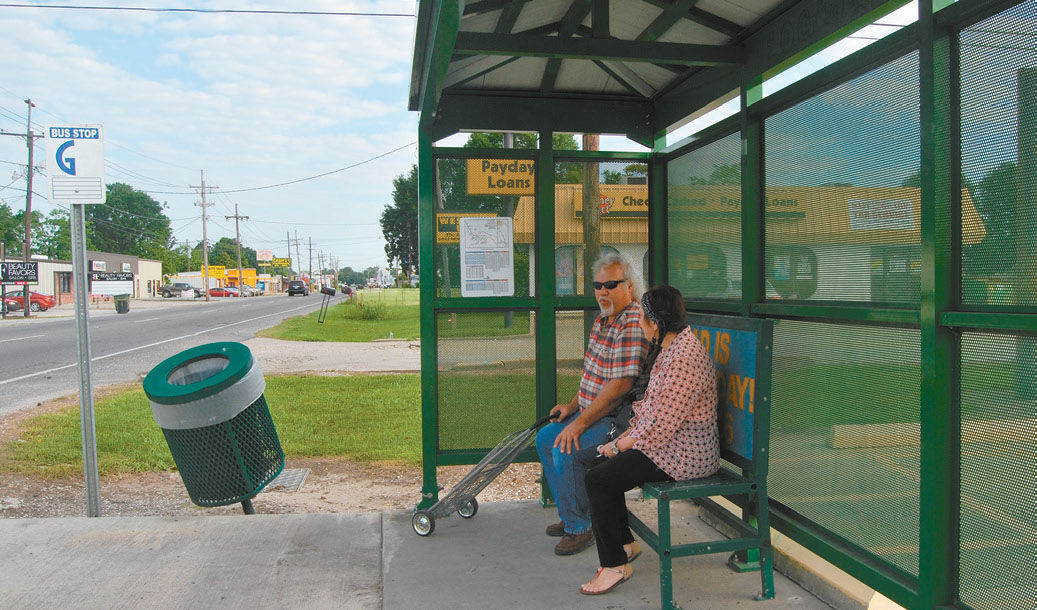
‘There she is…’ Queen Courtney Salas to reign at 2015 Rougarou Festival
May 6, 2015
SULPHUR-BOUND!
May 13, 2015Lafourche residents could receive door-to-door van service to and from almost anywhere in the parish, as part of the parish government’s plan for improving access to public transportation.
The proposal is among several presentee to the Lafourche Parish Council by the South Central Planning Commission to meet what officials say is growing demand for public transit options.
SCPDC planner Adam Tatar presented the options at the council’s April 28 meet-
ing.
It’s how pedestrians in St. James Parish get around, Tatar said. “All of their transit service is a demand-response.”
A demand-response model of public-transportation is what parish Council on Aging offices provide for seniors with their familiar short white busses. The senior calls in advance and a bus driver picks them up for trips to medical offices or grocery stores,
Lafourche Parish commissioned SCDPC in October to perform a transit feasibility study; Tatar presented interim findings.
The study’s objective is to gather data and determine if parish-wide public transportation is feasible and, if so, which types of transportation would best meet residents’ needs.
Seniors are the demographic most reliant on transportation due to physical or financial constraints, according to the SCPDC study, which reported that as baby boomers age, the demand for public service will rise.
Good Earth Transit, Terrebonne Parish’s public transportation system, currently provides limited bus service in Lafourche.
Houma resident Patsy Voisin frequently uses the Terrebonne system traveling to and from Wal-mart. Her experience underscores elements of the Lafourche presentation.
“A lot of people down the bayous don’t have any transportation other than if they get a cab, which is ridiculously expensive,” said Voisin, who spends $14 round-trip.
But on the other side of the spectrum, young adults utilize public transport as a choice, the report says, citing U.S. Department of Transportation data.
The SCPDC study, citing 2010 U.S. Census data, found of Lafourche’s nearly 100,000 residents, 2.4 percent of workers have no access to a car and over 20 percent live in a household with only one car, often owned by another employed household members.
More than 14 percent of Lafourche residents live below the poverty line and generally live around densely populated areas, such as Thibodaux and Golden Meadow.
The SCPDC determined there is a widespread need for public transit along Bayou Lafourche.
River Parishes Transit Authority, created with the SCPDC’s guidance, provides demand-response service to St. Charles, St. James and St. John the Baptist parishes with five 10-12 passenger busses, each equipped with a wheelchair lift, 14 hours daily, six days a week.
But the service, in practice, has some wrinkles that officials haven’t figured out how to iron.
Robert Collins, operations manager for Veolia Transdev, the service provider for the RPTA, said three of those busses service St. John. Each bus averages 20 passengers daily and travels as far as Kenner for $2 per trip.
St. John is estimated to have nearly 44,000 residents, more than 16 percent of whom live below the poverty line, according to the Census.
But since demand for the service is high, it is offered on a first-come, first-served basis. The RPTA turns down 20 to 30 St. John residents each day, Collins said. He said many people just give up.
“If I had a higher service level, and I could provide more service to the people that are calling, I would still have more people calling that still couldn’t get rides,” Collins observed.
He estimates the RPTA serves a 700-square-mile area. If the three busses were limited to a smaller geographic area, service would improve.
Comparatively, Lafourche is 1,068 square miles.
Regardless, Collins said demand-response is still ideal for rural areas in need of public transit services.
The SCPDC report outlines a pilot demand-response program with three vans costing the parish approximately $150,000. Grants from the state and the federal Highway Trust Fund would cover 85 percent of the costs for the buses, the rest to be covered by the parish.
State and federal grants would also cover 50 percent of the operating costs, which the report estimates to cost a total of $261,500 yearly.
The SCPDC expects to drive 40-to-50 passengers a day, making an estimated 14,400 trips annually.
The price to ride is up to the parish and the service provider to decide, Tatar said, and could range from $2-to-$10.
“Generally, demand-response ends up costing more per passenger because you don’t have the volume that you do on a fixed route,” Tatar explained.
He added that no fare charged by a demand-response public transit program could ever recoup the actual cost. Some public transit advocates suggest the cost of merely collecting the fare is so high that it’s more worthwhile to charge no fare at all.
Tatar also said riders with destinations as far as New Orleans would feasibly pay proportionately higher fares should the program expand that far.
Tatar said a Lafourche program could realistically be operational in a year.
Lafourche Parish Administrator Archie Chaisson said the parish government is pursuing the program.
After the demand-response program is up and running, the SCPDC will get a better idea of where transit options are most needed, the report says.
Demand-response service is one of three different programs proposed to the parish council. Another, more ambitious program, would be a fixed bus route extending from Thibodaux to Golden Meadow.
That bus, Tatar said, could also make deviations from the fixed route upon request. More than likely, though, it would be an express bus with limited stops in major towns along the way running two times daily.
“Whatever service that the parish wants to go with, I certainly imagine a lot of tweaking and adjustments,” Tatar said.
Another possibility offered in the report would be an express shuttle to Port Fourchon, although many companies already contract with private transit firms to shuttle workers who commute to the port.
Greater Lafourche Port Commission Executive Director Chett Chiasson was unsure of the demand for a public transit service specifically to the port. He said many groups have approached the port commission and individual companies about creating park-and-ride options between Galliano and Port Fourchon, but “they have not had anyone actually do that yet.”
Port Commission Board Member Jimmy Guidry was much more supportive of the idea.
“We have, on the ground at the docks, we’ve probably got 2,000 jobs,” Guidry said. “Probably close to 50 percent [live] further away than, let’s say, 20 miles away. Maybe even 40 miles away.”
Joseph Guidry and Patsy Voisin wait for a bus on West Park Avenue in Houma. Demand for public transit options is expected to grow across the nation and Lafourche Parish is exploring them.
A Terrebonne Parish public bus makes its way through Downtown Houma on the North Bayou Route. The first draft of a study to see if a similar public transit system would be feasible in Lafourche Parish was presented to the council of April 28.













